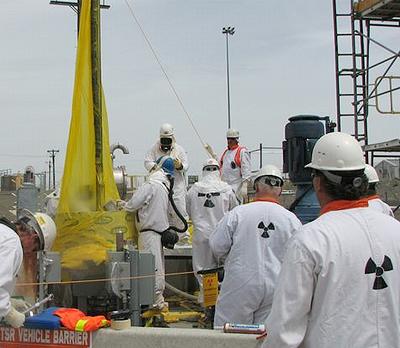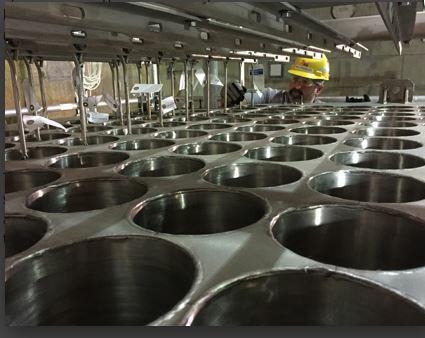
RICHLAND, Washington, January 12, 2021 (ENS) – The U.S. Department of Energy is poised to complete a cleanup commitment that has been decades in the making – immobilizing in glass the least radioactive portion of the tank waste at the Hanford Nuclear Reservation in south central Washington State.
For more than 40 years, nuclear reactors at Hanford produced plutonium for America’s defense program. Beginning in 1943, the site was used to produce plutonium for the bomb that brought an end to World War II. Production was ramped up again in 1947 to meet the challenges of the Cold War and continued until 1987 when the last reactor stopped operation.
On Thursday, the U.S. Department of Energy which operates the Hanford Site under an agreement with the U. S. Environmental Protection Agency and the State of Washington, announced that Hanford workers have completed construction of the Waste Treatment Plant’s Low Activity Waste Facility. Under construction for 18 years, completion of the facility will mark a milestone at the Hanford site.

The process of making plutonium produces a massive amount of liquid and solid waste but only a small amount of plutonium. Besides the millions of tons of solid waste, hundreds of billions of gallons of radioactive liquid waste were also generated during the plutonium production days. These liquid wastes were disposed of by pouring them onto the ground or into trenches or holding ponds. Unintentional spills of liquids took place, the DOE admits.
Liquid wastes generated during the process of extracting plutonium from the uranium fuel rods were put into dozens of giant underground storage tanks. As with the solid wastes, while some records accurately describe the kinds of liquid wastes that were generated and where they went, some of the spills and the volume of the spills went undocumented.
Today, crews responsible for the Hanford cleanup are dealing with several different kinds of waste in various forms, many potentially harmful to people and the environment. Hanford contractors say precautions have been taken so that the waste does not contaminate the air, the ground, the water table beneath the ground, the Columbia River, the people who are doing the cleanup work, or the people and environment near the Hanford Site.
Of the liquid wastes generated at Hanford, much waste that is currently stored in the underground tanks on the site will be transformed into a stable, glass product in a process called vitrification. In order to vitrify the waste, it is mixed with glass-forming materials and then introduced to high heat in order for the waste to bond with the glass.
The Waste Treatment Plant’s Low Activity Waste facility will perform this vitrification work. About 90 percent of the 56 million gallons of waste stored in Hanford’s underground tanks is low-activity waste.
Once the vitrification process has taken place, the resulting molten, glass-like material is poured into cylinders where it will cool and become solid. Ultimately, cylinders containing the most hazardous vitrified waste will be taken to a national repository for permanent burial. But that repository does not now exist.
Once Hanford’s Low Activity Waste facility has finished the start-up, testing, and commissioning phases, the vitrification will begin through the Direct-Feed Low-Activity Waste, DFLAW, program.
“Direct-feed” means the waste is separated at a double-shell tank farm to remove the more radioactive portion – solids and cesium – so that the resulting low-activity, less radioactive, waste can be fed directly to the Waste Treatment and Immobilization Plant’s Low-Activity Waste (LAW) Facility for immobilization in glass.
“The Department is committed to the shared goal of initiating tank waste treatment at Hanford via DFLAW,” said Deputy Secretary of Energy Mark Menezes on a visit to Hanford on Thursday. “This progress marks a tremendous leap forward for the Hanford workforce and the Tri-Cities community as we drive closer to a new era of tank waste treatment at Hanford.”

DOE’s Under Secretary for Science, Paul Dabbar, joined the deputy secretary at Hanford to view the progress made. “The focus on solutions combined with a world-class workforce on the ground has led to results for the tank waste mission and beyond,” said Dabbar. “The impacts of this DFLAW achievement coupled with the overall progress of the past four years position Hanford for success throughout the decade ahead.”
Engineering, procurement, and construction have been completed on 17 facilities at the Waste Treatment Plant, which will be used in the DFLAW approach.
The facilities include the analytical laboratory, effluent management facility, and 14 support structures – electrical power, backup power, water purification, compressed air, steam, communication and control, and fire water systems.
The 17 facilities are now in the start-up, testing, and commissioning phases to prepare for operations and the next major achievement – heating up large melters that will vitrify millions of gallons of low-activity tank waste.
The DFLAW focus now shifts to preparing for the start of cold commissioning of the Low Activity Waste Facility. At that time, a waste-like simulant will be run through the facility to test systems, plant monitoring, and management of systems.
Progress at Hanford includes the completion of construction of other facilities needed to start treating radioactive waste from the large underground tanks using the DFLAW approach.
In addition to handling the low activity waste, all of the facilities and structures that were associated with Hanford’s defense mission must also be deactivated, decommissioned, decontaminated, and demolished. That environmental cleanup project is the work in which some 8,000 Hanford employees are involved today.
Copyright Environment News Service (ENS) 2021. All rights reserved.



